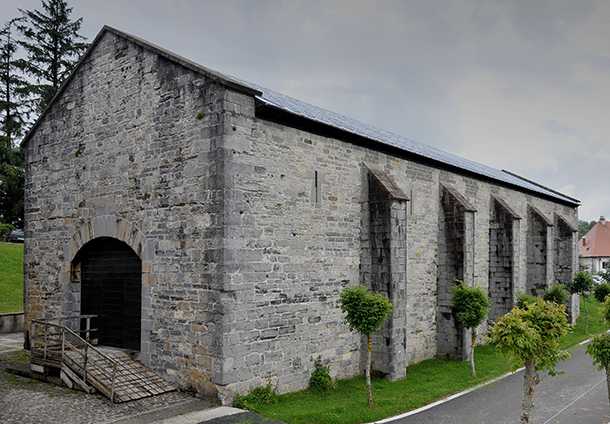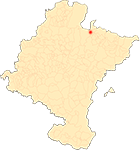Roncesvalles
By Javier Martínez de Aguirre Aldaz
Itzandeguía
The ancient appearance of the building known as Itzandeguía, located on the other side of the road, more or less at the height of the chapel of Santiago, has given rise to legendary tales since ancient times. According to an old tradition, the image of Saint Mary would have appeared in the Virgin's source , at her feet. Of course, this story lacks any historical basis, since the titular image of the temple dates from much later than the church of Santa María.
From the 16th century onwards it was used as a barn, stables, housing for the hospital servants and residency program for carabinieri. In the 20th century it was used as a stable and granary on the ground floor leave and as living quarters on the upper floors (at that time the walls had been built up). In 1903, three large interior arches belonging to the original construction were demolished. The current state is result of a restoration carried out at the end of the 20th century, which has recovered the large single nave covered with wooden framework on transversal arches supported by powerful buttresses (two were visible on the north wall and one on the south). Loopholes open between each bay, which were recognisable despite the late opening of anarchically distributed openings. Access is through a large segmental-arched doorway on the west façade, which had been bricked up and modified. There is a second lintelled doorway in the second section of the northern façade.
The building typology consisting of single wide aisles, covered by transversal stone arches that support a simple wooden gable roof, was very common in buildings for non-religious use (hospitals, dormitories, refectories, warehouses) throughout the whole of the Middle Ages average. Hence, different original uses have been proposed for Itzandeguía, from a hospital building (remember that the 13th century poem La Preciosa differentiated between houses dedicated to men and women, and that a donation from 1203 spoke of the old and new hospitals) to storeroom. As there are no constructive elements with a clear chronological ascription, it is not easy to conclude a date for the building.
Dectot, X., "Yacente de Sancho VII el Fuerte", in Bango Torviso, I.G. (dir. cient.), Sancho el Mayor y sus herederos. El linaje que europeizó los reinos hispanos, Pamplona, 2006, pp. 371-373.
Fernández-Ladreda, C., Imaginería medieval mariana en Navarra, Pamplona, 1989.
Fernández-Ladreda, C. (Dir.), Martínez Álava, C., Martínez de Aguirre, J. and Lacarra Ducay, M.C., El arte gótico en Navarra, Pamplona, 2015.
Fuentes y Ponte, J., report histórica y descriptiva del santuario de Nuestra Señora de Roncesvalles, Lérida, 1880.
García Gainza, M.C., Orbe Sivatte, M. and Domeño Martínez de Morentin, A., Catalog Monumental de Navarra IV**. Merindad de Sangüesa, Pamplona, 1992.
Ibarra, J., History of Roncesvalles. Art. History. Legend, Pamplona, 1936.
Lambert, E. Roncevaux", Bulletin Hispanique, XXXVII (1935), pp. 417-436.
Martínez de Aguirre, J. (coord.), Enciclopedia del Románico en Navarra, Aguilar de Campoo, 2008, vol. III, pp. 1216-1224.
Martínez de Aguirre, J., Gil Cornet, L. and Orbe Sivatte, M., Roncesvalles. Hospital and sanctuary on the Camino de Santiago, Pamplona, 2012.
Miranda García, F. and Ramírez Vaquero, E., Roncesvalles, Pamplona, 1999.
Peris, A., "El Ritmo de Roncesvalles: estudio y edición", Cuadernos de Filología Clásica. Latin Studies, 11 (1996), pp. 171-209.
Pons Sorolla, F., "project de obras de restauración en la capilla del Sancti Spiritus de la Real Colegiata de Roncesvalles (Navarra)", Príncipe de Viana, XXXIX (1978), pp. 59-77.
Soria i Puig, A., The Road to Santiago. II. Stations and signs, Madrid, 1992.
Torres Balbás, L. La iglesia de la hospedería de Roncesvalles", Príncipe de Viana, VI (1945), pp. 371-403.
Thuile, J., L'Orfèvrerie en Languedoc du XIIe au XVIIIe siècle. Généralité de Montpellier, Montpellier, 1966.












